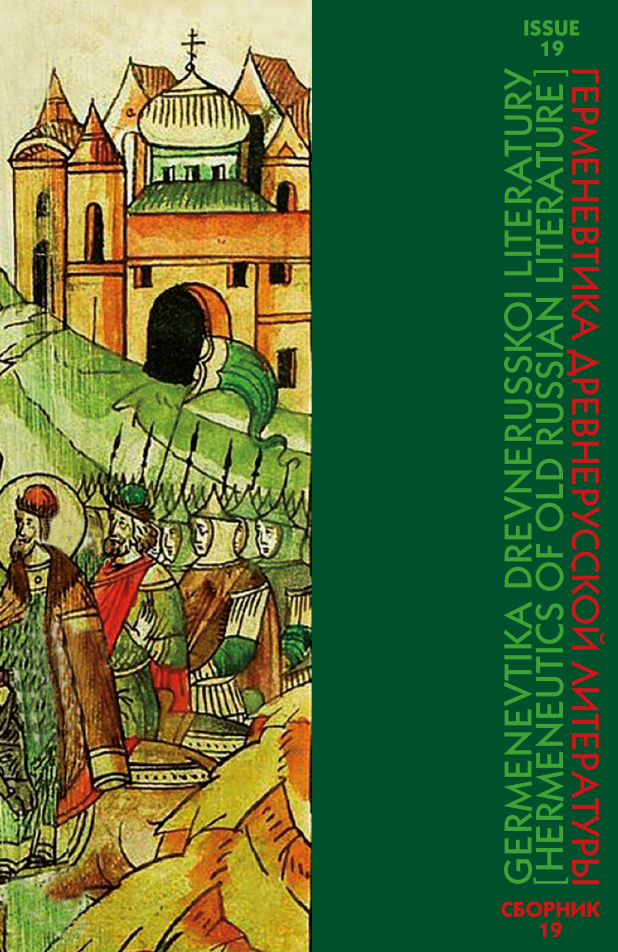Abstract:
The article examines the episodes about the posthumous miracles of St. Peter which were included in various Old Russian annalistic collections in the form of separate records dedicated to the veneration and praise of the Moscow Metropolitan Peter as a great saint of God, a particularly revered heavenly patron of Moscow. This article examines the most significant stories about the posthumous miracles of the Moscow Metropolitan Peter in the chronicles of 15th–16th centuries (Simeonovskaya, Sofia second, Voskresenskaya, Nikonovskaya, Pskov chronicles, Moscow annalistic collection of the end of 15th century), analyzed the functions and stylistic features of these stories. The varieties of the posthumous miracles of St. Peter presented in the chronicles of the 15th–16th centuries can be divided into miracles of healing, miracles of helping children (“children’s” miracles), miracles of protecting cities and helping in battles, gratitude to the saint in victory over the enemy, miraculous phenomenon of the saint and his relics and miracles about salvation from disease. The main characteristics of posthumous miracles are their concreteness and narrative plot. The main feature of the image in the considered posthumous miracles can be considered the desire of the chroniclers to idealize the protagonist, as well as the simplicity of presentation, the abundance of everyday and specific details and information. Information about the posthumous miracles of the Moscow Metropolitan Peter, used in the annalistic monuments, helped to create a historical background for the described events and current historical characters, and also reinforced the fact of the saint’s holiness. The considered episodes from the chronicles contain factual details and information concerning the personality of St. Peter the Wonderworker, who is considered the heavenly patron of Moscow.
References:
- “Voskresenskaia letopis’ (prodolzhenie po Voskresenskomu spisku)” [“Voskresensky Chronicle (continued according to the Voskresensky list)”]. Polnoe sobranie russkikh letopisei [Complete Collection of Russian Chronicles], vol. VIII. Moscow, Iazyki russkoi kul’tury Publ., 2000. 312 p. (In Russian)
- “Letopisnyi sbornik, imenuemyi Patriarshei ili Nikonovskoi letopis’iu” [“Chronicle Collection, Referred to the Patriarch or Nikon Chronicle”]. Polnoe sobranie russkikh letopisei [Complete Collection of Russian Chronicles], vol. XIII. Moscow, Iazyki russkoi kul’tury, 2000. 544 p. (In Russian)
- Loparev, Kh.M. Grecheskie zhitiia sviatykh VIII i IX vekov. Opyt nauchnoi klassi- fikatsii pamiatnikov agiografii [Greek Lives of Saints of the 8th and 9th Centuries. Experience of Scientific Classification of Hagiography Monuments], part 1. Petrograd, Tipografiia Akademii nauk Publ., 1914, pp. 16–36. (In Russian)
- “Moskovskii letopisnyi svod kontsa XV veka” [“Moscow Annals of the Late 15thCentury”]. Polnoe sobranie russkikh letopisei [Complete Collection of Russian Chronicles], vol. XXV. Moscow, Iazyki russkoi kul’tury, 2004. 488 p. (In Russian)
- Prokof ’ev, N.I. “O mirovozzrenii russkogo srednevekov’ia i sisteme zhanrov russkoi literatury XI–XVI vv.” [“On the Worldview of the Russian Middle Ages and the System of Genres of Russian Literature in the 11th–16th Centuries”]. Literatura Drevnei Rusi [Literature of Old Russia], issue 1. Moscow, MPGU im. V.I. Lenina Publ., 1975, pp. 5–37. (In Russian)
- “Pskovskaia pervaia letopis’” [“Pskov First Chronicle”]. Polnoe sobranie russkikh letopisei [Complete Collection of Russian Chronicles], vol. V, issue 1. Moscow, Iazyki russkoi kul’tury, 2003. 256 p. (In Russian)
- “Simeonovskaia letopis’” [“Simeon Chronicle”]. Polnoe sobranie russkikh letopisei [Complete Collection of Russian Chronicles], vol. XVIII. Moscow, Znak, 2007. 328 p. (In Russian)
- “Skazanie o Mamaevom poboishche” [“The Legend of the Mamai Massacre”]. Pamiatniki literatury Drevnei Rusi. XIV — seredina XV veka [Literary Monuments of Old Russia. 14th — mid-15th Century]. Moscow, Khudozhestvennaia literature Publ., 1981, pp. 134–189. (In Russian)
- “Sofiiskaia vtoraia letopis’” [“Sofia the Second Chronicle”]. Polnoe sobranie russkikh letopisei [Complete Collection of Russian Chronicles], vol. VI, issue 2. Moscow, Iazyki russkoi kul’tury, 2001. 240 p. (In Russian)
- Starodumov, I.V. Zhanrovaia spetsifika povestvovanii o posmertnykh chudesakh sviatykh podvizhnikov v sostave drevnerusskoi agiografii [The Genre Specificity of the Narratives about the Posthumous Miracles of the Holy Ascetics as a Part of Old Russian Hagiography: PhD thesis, summary]. Omsk, 2009. 20 p. (In Russian)
- Trofimova, N.V. “Chudesa v drevnerusskom voinskom povestvovanii” [“Miracles in the Old Russian Warrior Narrative”]. Vestnik Riazanskogo gosudarstvennogo universiteta im. S.A. Esenina, no. 4/33, 2011, pp. 72–79. (In Russian)






